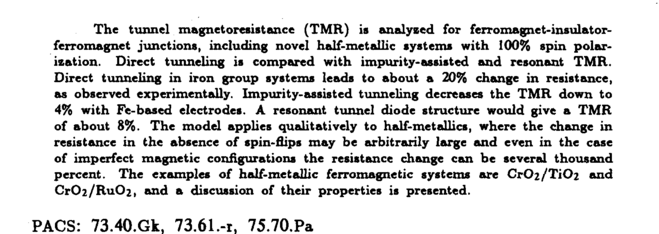|
|

| VOLUME 65 (1997) | ISSUE 5 |
PAGE 430
|
The possibility of a very large magnetoresistance in half-metallic oxide systems
Bratkovsky A.M.
The tunnel magnetoresistance (TMR) is analyzed for ferromagnet-insulator-ferromagnet junctions, including novel half-metallic systems with 100% spin polarization. Direct tunneling is compared with impurity-assisted and resonant TMR. Direct tunneling in iron group systems leads to about a 20% change in resistance, as observed experimentally. Impurity-assisted tunneling decreases the TMR down to 4% with Fe-based electrodes. A resonant tunnel diode structure would give a TMR of about 8%. The model applies qualitatively to half-metallics, where the change in resistance in the absence of spin-flips may be arbitrarily large and even in the case of imperfect magnetic configurations the resistance change can be several thousand percent. The examples of half-metallic ferromagnetic systems are óÇïÇ/ôàÇ and Cr02/Ru02, and a discussion of their properties is presented. PACS: 73.40.Gk, 73.61.-r, 75.70.Pa
|
|


